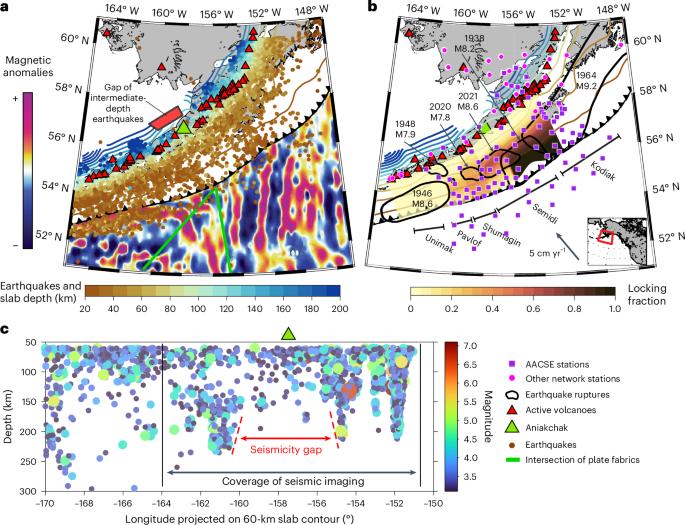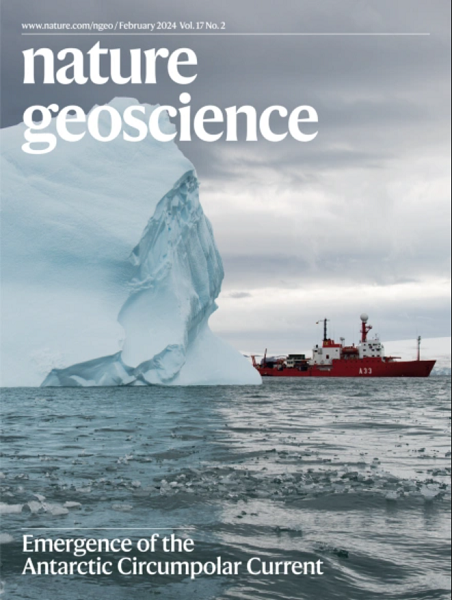沿着阿拉斯加半岛下俯冲的大洋板块接合处的板块撕裂
IF 16.1
1区 地球科学
Q1 GEOSCIENCES, MULTIDISCIPLINARY
引用次数: 0
摘要
在全球的俯冲带中,已经推断出俯冲板块的各种性质沿海沟变化,但对这些变化的原因仍然知之甚少。在阿拉斯加半岛上,小于50 km深度的板(脱)水化作用和流体的变化不能解释150 km以下的地震活动间隙,也不能解释Aniakchak火山周围火山密度和弧向的突变。在这里,我们使用地震全波环境噪声层析成像来研究这些观测结果的原因。我们的三维横波速度模型显示,在约50公里以下有多个高速板块,在Aniakchak下方有一个速度更低的板块。这一低速段与推断出的俯冲洋板块接合位置(两组板块构造相交的位置)以及地震各向异性所显示的软流圈板块法向快速方向相吻合。推断俯冲洋节理促进了板块的弱化和撕裂,在150 km以下形成板块窗,解释了地震活动间隙和板块-正交地幔流动。因此,我们认为大洋板块节理可能作为板块的潜在薄弱带发挥重要作用,从而潜在地影响俯冲动力学和地震活动性。本文章由计算机程序翻译,如有差异,请以英文原文为准。


Slab tearing along a subducted oceanic plate joint beneath the Alaska Peninsula
Along-trench variations in various properties of subducted slabs have been inferred in subduction zones globally, yet the causes of these variations remain poorly understood. Along the Alaska Peninsula, the variation of slab (de)hydration and fluids shallower than 50-km depth cannot explain a seismicity gap below 150 km nor the abrupt changes in volcano density and arc orientation around Aniakchak volcano. Here we investigate the cause of these observations using seismic full-wave ambient noise tomography. Our 3D shear-wave velocity model reveals multiple high-velocity slab segments below about 50 km, with a much-lower-velocity segment broadly below Aniakchak. This low-velocity segment coincides with the inferred location of a subducted oceanic plate joint, where two sets of plate fabrics intersect, and with slab-normal fast directions in the asthenosphere indicated by seismic anisotropy. We infer that the subducted oceanic joint facilitated slab weakening and tearing, which has developed into a slab window below about 150 km, explaining the seismicity gap and slab-orthogonal mantle flow. Hence we suggest that oceanic plate joints may have an important role as potential weak zones in slabs and thus potentially influence subduction dynamics and seismicity. An oceanic plate joint, where two sets of plate fabrics intersect, may have led to weakening, tearing and a window opening in the slab subducting beneath the Alaska Peninsula, according to ambient noise seismic tomography.
求助全文
通过发布文献求助,成功后即可免费获取论文全文。
去求助
来源期刊

Nature Geoscience
地学-地球科学综合
CiteScore
26.70
自引率
1.60%
发文量
187
审稿时长
3.3 months
期刊介绍:
Nature Geoscience is a monthly interdisciplinary journal that gathers top-tier research spanning Earth Sciences and related fields.
The journal covers all geoscience disciplines, including fieldwork, modeling, and theoretical studies.
Topics include atmospheric science, biogeochemistry, climate science, geobiology, geochemistry, geoinformatics, remote sensing, geology, geomagnetism, paleomagnetism, geomorphology, geophysics, glaciology, hydrology, limnology, mineralogy, oceanography, paleontology, paleoclimatology, paleoceanography, petrology, planetary science, seismology, space physics, tectonics, and volcanology.
Nature Geoscience upholds its commitment to publishing significant, high-quality Earth Sciences research through fair, rapid, and rigorous peer review, overseen by a team of full-time professional editors.
 求助内容:
求助内容: 应助结果提醒方式:
应助结果提醒方式:


